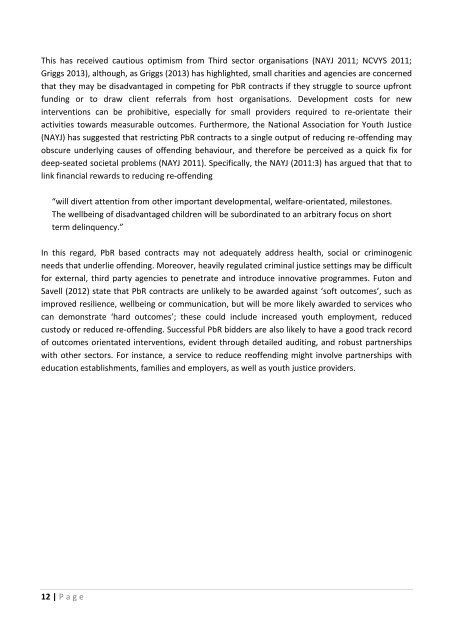De Viggiani, N., Daykin, N., Moriarty, Y. and Pilkington, P. and ...
De Viggiani, N., Daykin, N., Moriarty, Y. and Pilkington, P. and ...
De Viggiani, N., Daykin, N., Moriarty, Y. and Pilkington, P. and ...
Create successful ePaper yourself
Turn your PDF publications into a flip-book with our unique Google optimized e-Paper software.
This has received cautious optimism from Third sector organisations (NAYJ 2011; NCVYS 2011;<br />
Griggs 2013), although, as Griggs (2013) has highlighted, small charities <strong>and</strong> agencies are concerned<br />
that they may be disadvantaged in competing for PbR contracts if they struggle to source upfront<br />
funding or to draw client referrals from host organisations. <strong>De</strong>velopment costs for new<br />
interventions can be prohibitive, especially for small providers required to re-orientate their<br />
activities towards measurable outcomes. Furthermore, the National Association for Youth Justice<br />
(NAYJ) has suggested that restricting PbR contracts to a single output of reducing re-offending may<br />
obscure underlying causes of offending behaviour, <strong>and</strong> therefore be perceived as a quick fix for<br />
deep-seated societal problems (NAYJ 2011). Specifically, the NAYJ (2011:3) has argued that that to<br />
link financial rewards to reducing re-offending<br />
“will divert attention from other important developmental, welfare-orientated, milestones.<br />
The wellbeing of disadvantaged children will be subordinated to an arbitrary focus on short<br />
term delinquency.”<br />
In this regard, PbR based contracts may not adequately address health, social or criminogenic<br />
needs that underlie offending. Moreover, heavily regulated criminal justice settings may be difficult<br />
for external, third party agencies to penetrate <strong>and</strong> introduce innovative programmes. Futon <strong>and</strong><br />
Savell (2012) state that PbR contracts are unlikely to be awarded against ‘soft outcomes’, such as<br />
improved resilience, wellbeing or communication, but will be more likely awarded to services who<br />
can demonstrate ‘hard outcomes’; these could include increased youth employment, reduced<br />
custody or reduced re-offending. Successful PbR bidders are also likely to have a good track record<br />
of outcomes orientated interventions, evident through detailed auditing, <strong>and</strong> robust partnerships<br />
with other sectors. For instance, a service to reduce reoffending might involve partnerships with<br />
education establishments, families <strong>and</strong> employers, as well as youth justice providers.<br />
12 | P a g e
















